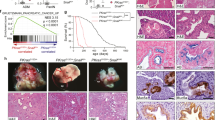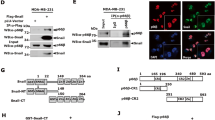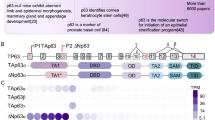Abstract
The Snail family of transcription factors has previously been implicated in the differentiation of epithelial cells into mesenchymal cells (epithelial–mesenchymal transitions) during embryonic development. Epithelial–mesenchymal transitions are also determinants of the progression of carcinomas, occurring concomitantly with the cellular acquisition of migratory properties following downregulation of expression of the adhesion protein E-cadherin. Here we show that mouse Snail is a strong repressor of transcription of the E-cadherin gene. Epithelial cells that ectopically express Snail adopt a fibroblastoid phenotype and acquire tumorigenic and invasive properties. Endogenous Snail protein is present in invasive mouse and human carcinoma cell lines and tumours in which E-cadherin expression has been lost. Therefore, the same molecules are used to trigger epithelial–mesenchymal transitions during embryonic development and in tumour progression. Snail may thus be considered as a marker for malignancy, opening up new avenues for the design of specific anti-invasive drugs.
This is a preview of subscription content, access via your institution
Access options
Subscribe to this journal
Receive 12 print issues and online access
$209.00 per year
only $17.42 per issue
Buy this article
- Purchase on SpringerLink
- Instant access to full article PDF
Prices may be subject to local taxes which are calculated during checkout








Similar content being viewed by others
References
Bursdal, C. A., Damsky, C. H. & Pedersen, R. A. The role of E-cadherin and integrins in mesoderm differentiation and migration at the mammalian primitive streak. Development 118, 829–844 (1993).
Levine, E., Lee, C. H., Kintner, C. & Gumbiner, B. M. Selective disruption of E-cadherin function in early Xenopus embryos by a dominant negative mutant. Development 120, 901–909 (1994).
Larue, L., Ohsugi, M., Hirchenhain, J. & Kemler, R. E-cadherin null mutant embryos fail to form a trophoectoderm epithelium. Proc. Natl Acad. Sci. USA 91, 8263–8267 (1994).
Riethmacher, D., Brinkmann, V. & Birchmeier, C. A targeted mutation in the mouse E-cadherin gene results in defective preimplantation development. Proc. Natl Acad. Sci. USA 92, 855–859 (1995).
Gumbiner, B. M. Cell adhesion: the molecular basis of tissue architecture and morphogenesis. Cell 84, 345–357 (1996).
Wheelock, M. J. & Jensen, P. J. Regulation of keratinocyte intercellular junction organization and epidermal morphogenesis by E-cadherin. J. Cell Biol. 117, 415–425 (1992).
Takeichi, M. Morphogenetic roles of classic cadherins. Curr. Opin. Cell Biol. 7, 619–627 (1995).
Huber, O., Bierkamp, C. & Kemler, R. Cadherins and catenins in development. Curr. Opin. Cell Biol. 8, 685–691 (1996).
Nieto, M. A., Sargent, M. G., Wilkinson, D. G. & Cooke, J. Control of cell behaviour during vertebrate development by Slug, a zinc finger gene. Science 264, 835–839 (1994).
Takeichi, M. Cadherins in cancer: implications for invasion and metastasis. Curr. Opin. Cell Biol. 5, 806–811 (1993).
Birchmeier, W. & Behrens, J. Cadherin expression in carcinomas: role in the formation of cell junctions and the prevention of invasiveness. Biochim. Biophys. Acta 1198, 11–26 (1994).
Perl, A. K., Wilgenbus, P., Dahl, U., Semb, H. & Christofori, G. A causal role for E-cadherin in the transition from adenoma to carcinoma. Nature 392, 190–193 (1998).
Frixen, U. H. et al. E-cadherin-mediated cell-cell adhesion prevents invasiveness of human carcinoma cells. J. Cell Biol. 113, 173–185 (1991).
Vleminckx, K., Vakaet, L. J., Mareel, M., Fiers, W. & Van Roy, F. Genetic manipulation of E-cadherin expression by epithelial tumor cells reveals an invasion suppressor role. Cell 66, 107–119 (1991).
Miyaki, M. et al. Increased cell-substratum adhesion, and decreased gelatinase secretion and cell growth, induced by E-cadherin transfection of human colon carcinoma cells. Oncogene 11, 2547–2552 (1995).
Llorens, A. et al. Downregulation of E-cadherin in mouse skin carcinoma cells enhances a migratory and invasive phenotype linked to matrix metalloproteinase-9 gelatinase expression. Lab. Invest. 78, 1–12 (1998).
Behrens, J., Löwrick, O., Klein, H. L. & Birchmeier, W. The E-cadherin promoter: functional analysis of a GC-rich region and an epithelial cell-specific palindromic regulatory element. Proc. Natl Acad. Sci. USA 88, 11495–11499 (1991).
Ringwald, M., Baribault, H., Schmidt, C. & Kemler, R. The structure of the gene coding for the mouse cell adhesion molecule uvomorulin. Nucleic Acids Res. 19, 6533–6539 (1991).
Bussemakers, M. J., Giroldi, L. A., van Bokhoven, A. & Schalken, J. A. Transcriptional regulation of the human E-cadherin gene in human prostate cancer cell lines: characterization of the human E-cadherin gene promoter. Biochem. Biophys. Res. Commun. 203, 1284–1290 (1994).
Giroldi, L. A. et al. Role of E-boxes in the repression of E-cadherin expression. Biochem. Biophys. Res. Commun. 241, 453–458 (1997).
Rodrigo, I., Cato, A. C. B. & Cano, A. Regulation of E-cadherin gene expression during tumor progression: the role of a new Ets-binding site and the E-pal element. Exp. Cell Res. 248, 358–371 (1999).
Hennig, G., Löwrick, O., Birchmeier, W. & Behrens, J. Mechanisms identified in the transcriptional control of epithelial gene expression. J. Biol. Chem. 271, 595–602 (1996).
Faraldo, M. L. M., Rodrigo, I., Behrens, J., Birchmeier, W. & Cano, A. Analysis of the E-cadherin and P-cadherin promoters in murine keratinocyte cell lines from different stages of mouse skin carcinogenesis. Mol. Carcinogen. 20, 33–47 (1997).
Mauhin, V., Lutz, Y., Dennefeld, C. & Alberga, A. Definition of the DNA-binding site repertoire for the Drososphila transcription factor SNAIL. Nucleic Acids Res. 21, 3951–3957 (1993).
Fuse, N., Hirose, S. & Hayashi, S. Diploidy of Drosophila imaginal cells is maintained by a transcriptional repressor encoded by escargot. Genes Dev. 8, 2270–2281 (1994).
Nakayama, H., Scott, I. C. & Cross, J. C. The transition to endoreduplication in trophoblast giant cells is regulated by the mSna zinc finger transcription factor. Dev. Biol. 199, 150–163 (1998).
Nieto, M. A., Bennet, M. F., Sargent, M. G. & Wilkinson, D. G. Cloning and developmental expression of Sna, a murine homologue of the Drosophila snail gene. Development 116, 227–237 (1992).
Smith D. E., Del Amo, F. F. & Gridley, T. Isolation of Sna, a mouse gene homologous to the Drosophila genes snail and escargot: its expression pattern suggests multiple roles during postimplantation development. Development 116, 1033–1039 (1992).
Savagner, P., Yamada, K. M. & Thiery, J. P. The zinc finger protein Slug causes desmosome dissociation, an initial and necessary step in growth factor-induced epithelial-mesenchymal transition. J. Cell. Biol. 137, 1403–1419 (1997).
Sefton, M., Sánchez, S. & Nieto M. A. Conserved and divergent roles for members of the Snail family of transcription factors in the chick and mouse embryo. Development 125, 3111–3121 (1998).
Jiang, R., Lan, Y., Norton, C. R., Sundberg, J. P. & Gridley, T. The Slug gene is not essential for mesoderm or neural crest development in mice. Dev. Biol. 198, 277–285 (1998).
Navarro, P. et al. A role for the E-cadherin cell-cell adhesion molecule in tumor progression of mouse epidermal carcinogenesis. J. Cell Biol. 115, 517–533 (1991).
Isaac, A., Sargent, M. G. & Cooke, J. Control of vertebrate left-right asymmetry by a Snail-related zinc finger gene. Science 275, 1301–1304 (1997).
Lozano, E. & Cano, A. Cadherin/catenin complexes in murine epidermal keratinocytes: E-cadherin complexes containing either β-catenin or plakoglobin contribute to stable cell-cell contacts. Cell Adhes. Commun. 6, 51–67 (1998).
Gómez, M., Navarro, P. & Cano, A. Cell adhesion and tumor progression in mouse skin carcinogenesis: increased synthesis and organization of fibronectin is associated with the undifferentiated spindle phenotype. Invasion Metastasis 14, 17–26 (1994).
Lozano, E. & Cano, A. Induction of mutual stabilization and retardation of tumor growth by coexpression of plakoglobin and E-cadherin in mouse skin spindle carcinoma cells. Mol. Carcinogen. 21, 273–287 (1998).
Hay, E. D. An overview of epithelio-mesenchymal transformation. Acta Anat. 154, 8–20 (1995).
Frontelo, P. et al. Transforming growth factor β1 induces squamous carcinoma cell variants with increased metastatic abilities and a disorganized cytoskeleton. Exp. Cell Res. 244, 420–432 (1998).
Yoshiura, K. et al. Silencing of the E-cadherin invasion-suppressor gene by CpG methylation in human carcinomas. Proc. Natl Acad. Sci. USA 92, 7416–7419 (1995).
Cano, A. et al. Expression pattern of the cell adhesion molecules E-cadherin, P-cadherin and α6β4 integrin is altered in pre-malignant skin tumors of p53-deficient mice. Int. J. Cancer 65, 254–262 (1996).
Oda, H., Tsukita, S. & Takeichi, M. Dynamic behavior of the cadherin-based cell-cell adhesion system during Drosophila gastrulation. Dev. Biol. 203, 435–450 (1998).
Ros, M., Sefton, M. & Nieto, M. A. Slug, a zinc finger gene previously implicated in the early patterning of the mesoderm and the neural crest, is also involved in chick limb development. Development 124, 1821–1829 (1997).
Navarro, P., Lozano, E. & Cano, A. Expression of E- or P-cadherin is not sufficient to modify the morphology and the tumorigenic behavior of murine spindle carcinoma cells. Possible involvement of plakoglobin. J. Cell Sci. 105, 923–934 (1993).
Hemavathy, K., Meng, X. & Ip, Y. T. Differential regulation of gastrulation and neuroectodermal gene expression by Snail in the Drosophila embryo. Development 124, 3683–3691 (1997).
Hay, E. D. Epithelial-mesenchymal transitions. Semin. Dev. Biol. 1, 347–356 (1990).
Duband, J. L., Monier, F., Delannet, M. & Newgreen, D. Epithelium-mesenchyme transition during neural crest development. Acta Anat. 154, 63–78 (1995).
Cook, D. M., Hinkes, M. T., Bernfield, M. & Rauscher F. J. III Transcriptional activation of the syndecan-1 promoter by the Wilms’ tumor protein WT1. Oncogene 13, 1789–1799 (1996).
Nieto, M. A., Patel, K. & Wilkinson, D. G. In situ hybridisation analysis of chick embryos in whole mount and tissue sections. Methods Cell Biol. 51, 220–235 (1996).
Acknowledgements
We thank G. Dhont for help with the one-hybrid screen; J.J. Arredondo for helpful advice in the design of this screen; A. Fabra for the human cell lines and tumours; M. Manzanares for help with the isolation of the human probe; M. Quintanilla for help in the tumorigenic assays; C. Bailón for assistance with confocal microscopy; C. Martinez for providing mouse embryos; A. Montes for technical assistance; M. Takeichi for the E-cadherin probe and ECCD-2 antibody; J. Behrens for E-cadherin promoter constructs; F.J. Rauscher for the pMT-CB6 vector; and M. Sefton for critical reading of the manuscript and editorial assistance. This work has been supported by the Spanish Ministry of Culture (grants DGICYT-PM95-0024 and PM98-0125 to M.A.N., SAF95-0818 and SAF98-0085-C03-01 to A.C., and PB97-0054 to F.P.), the Comunidad Autónoma de Madrid (grant 08.1/0020/97 to A.C. and M.A.N.) and the EU (grant FMRX-CT96-0065 to M.A.N).
Correspondence and requests for materials should be addressed to M.A.N. or A.C.
Author information
Authors and Affiliations
Corresponding authors
Rights and permissions
About this article
Cite this article
Cano, A., Pérez-Moreno, M., Rodrigo, I. et al. The transcription factor Snail controls epithelial–mesenchymal transitions by repressing E-cadherin expression. Nat Cell Biol 2, 76–83 (2000). https://doi.org/10.1038/35000025
Received:
Revised:
Accepted:
Published:
Issue Date:
DOI: https://doi.org/10.1038/35000025
This article is cited by
-
A milestone in epithelial–mesenchymal transition
Nature Cell Biology (2024)
-
DDR2-regulated arginase activity in ovarian cancer-associated fibroblasts promotes collagen production and tumor progression
Oncogene (2024)
-
Helicobacter pylori and Epstein-Barr virus infection in cell polarity alterations
Folia Microbiologica (2024)
-
Dissecting the multifaceted roles of autophagy in cancer initiation, growth, and metastasis: from molecular mechanisms to therapeutic applications
Medical Oncology (2024)
-
C3a/C3aR synergies with TGF-β to promote epithelial-mesenchymal transition of renal tubular epithelial cells via the activation of the NLRP3 inflammasome
Journal of Translational Medicine (2023)



